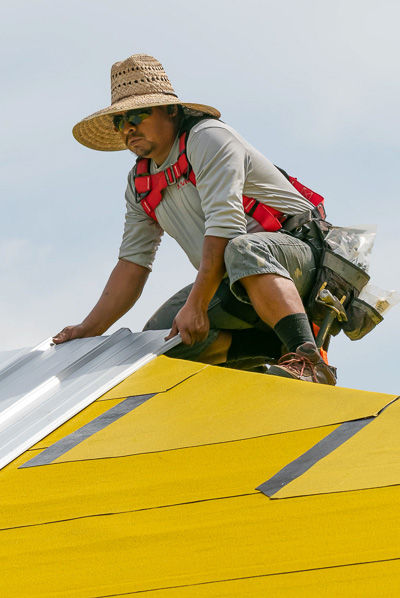Roof Growths: How to Treat and Prevent Mold, Algae and Moss on Your Asphalt Shingles
Published: 08/14/2020
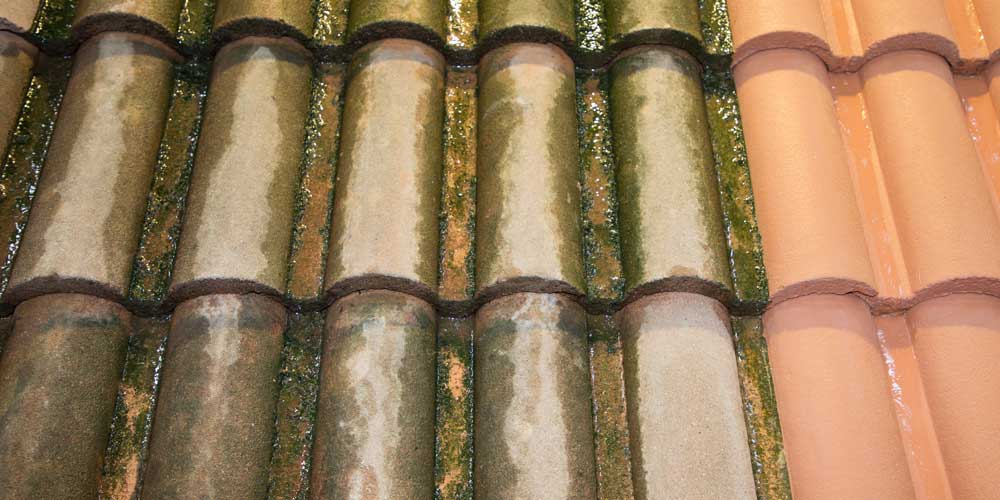
Depending on the roofing material you choose as well as the climate in which you reside, your roof can last 20–50 years. There are, however, some sneaky – but very common – problems that can compromise the integrity and lifespan of your roof. One of the most common roof problems is mold, or, to be more specific, algae, moss, lichen and mold, which are often used interchangeably by homeowners when describing their roofing woes.
In this post, we’ll break down the different types of roof growths, their causes and how you can eliminate and prevent them from coming back.
Types of roof growth
Algae
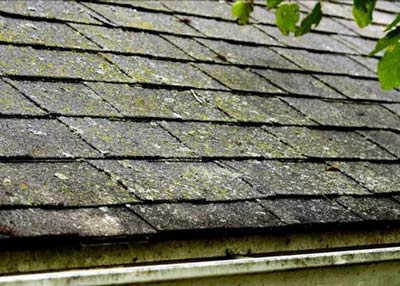 Algae is recognizable by its streaky black-green appearance. While many people refer to this as mold, it’s actually Gloeocapsa magma, or blue-green algae. The algae take on a blackish appearance due to the dark coating that protects it from sunlight. This growth is commonly seen on homes in warm, humid climates, and usually starts as small spots, but typically goes unnoticed by homeowners until it develops an ugly, streaky appearance, which takes at least two months.
Algae is recognizable by its streaky black-green appearance. While many people refer to this as mold, it’s actually Gloeocapsa magma, or blue-green algae. The algae take on a blackish appearance due to the dark coating that protects it from sunlight. This growth is commonly seen on homes in warm, humid climates, and usually starts as small spots, but typically goes unnoticed by homeowners until it develops an ugly, streaky appearance, which takes at least two months.
While algae can grow on all types of roofing, it particularly enjoys asphalt shingles, especially light-colored shingles. This is because the limestone aggregate on the shingles feeds the algae, allowing it to grow and thrive and depleting the protection the shingles are meant to provide. A damp roof encourages algal growth, so a home that sits in the shade is more likely to have algal growth than one that is exposed to full sun.
Mold
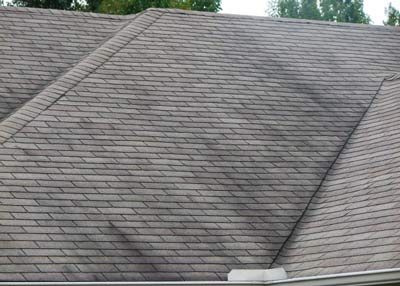 Mold is known to cause health problems in humans and animals and is easy to recognize due to the odor of decay and its unhealthy mottled black/brown/green appearance. The main cause of mold growth is unmitigated algae growth, which causes perpetual dampness. Collected moisture on absorbent building materials such as wood and drywall, as well as any organic matter (leaves, twigs, etc.) that has accumulated on the roof, encourages rot, which creates an inviting, habitable environment for mold.
Mold is known to cause health problems in humans and animals and is easy to recognize due to the odor of decay and its unhealthy mottled black/brown/green appearance. The main cause of mold growth is unmitigated algae growth, which causes perpetual dampness. Collected moisture on absorbent building materials such as wood and drywall, as well as any organic matter (leaves, twigs, etc.) that has accumulated on the roof, encourages rot, which creates an inviting, habitable environment for mold.
Homeowners can identify possible mold problems by the presence of the following conditions:
- Water damage/watermarks
- Discoloration/dark spots on walls, ceiling or rafters
- Peeling or bubbling paint
- Peeling, crumbling cracked or blistered plaster/drywall
- Wood rot
- Musty smell
- Dampness inside home
The Effects of Mold on the Home
While all roof types can be damaged by mold, moss, mildew and algae growth, wood and asphalt shingles are the most susceptible to the repercussions of unmitigated growth of these damaging malignancies. When an asphalt-shingle roof suffers from prolonged exposure to algae, mold and other growths, the trapped moisture can cause wood rot and early degradation of the roofing materials and eventual weakening of the roof’s integrity.
Eventually, the moisture and rot will spread to other areas of the structure to compromise those areas of the home as well. In regions that experience freezing winters, the trapped moisture will freeze and expand, causing cracks and stress on the shingles. The roof can suffer enough damage to begin leaking, which will lead to damage to the inside of your home as well as invite pests to invade your roof to nest.
Health Issues Resulting from Roof Mold
Mold is known to cause health problems in humans that range from mild to life-threatening. For some, inhaling mold spores can exacerbate allergic reactions, causing nasal and sinus irritation, runny nose, cough, sneezing and irritated eyes and skin. Others can suffer from more serious respiratory problems, such as asthma attacks, sinusitis and difficulty breathing.
There is no type of mold that is not dangerous to humans and pets, and the longer one is exposed to them, the greater the health risks.
Moss and Lichen
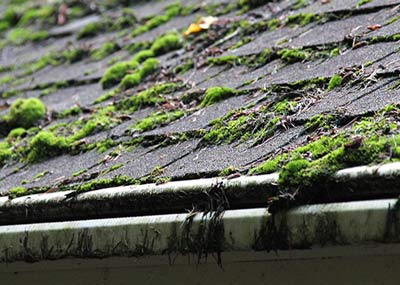 In addition to looking out for mold and algae, you should be aware that moss and lichen also enjoy growing on asphalt shingle roofs, especially in those areas that experience an abundance of shade.
In addition to looking out for mold and algae, you should be aware that moss and lichen also enjoy growing on asphalt shingle roofs, especially in those areas that experience an abundance of shade.
Moss can be characterized by its fuzzy, deep green appearance and its propensity to grow in splotches on the shingles. Moss is thick, so it absorbs and holds moisture on the shingles of the roof, which, as addressed earlier, leads to many roof problems, including total failure to protect the home from water damage.
Lichen is formed when fungal spores travel through the air and land on your roof, growing and rooting as it feeds on the algae and roofing material. Lichen can be more difficult to remove than algae, as well as cause more damage to the roofing due to the fact that it grows roots, which attach and penetrate the shingles. The roots have the potential to crack the shingles, creating exposed edges and causing premature failure.
Treatment, Elimination and Prevention
If the growth on your roof is relatively new and has not been left to spread for an excessive length of time, you may be able to have it treated without needing to shell out for expensive repairs.
If you’ve got moss and lichen, they’ll need to be carefully scraped off of the shingles using a plastic scraping tool without sharp corners that could potentially puncture roof tiles. Once the bulk of the growth is scraped away, a commercially-available herbicide or roof-cleaning product/zinc sulfate chemical solution can help to eradicate the remnants.
Some homeowners choose to clean the roof with a 50/50 mix of bleach and water; some also add TSP (trisodium phosphate) for extra cleaning power. Using this method, you’ll want to soak your foundation plantings with water prior to applying the solution to the roof. Once carefully applied, the solution should sit for about 5 minutes before rinsing off with a garden hose. *Never use a pressure washer on your roof, as it is likely to damage your roofing.
While bleach can kill mold on contact, homeowners should be aware of the risks of using bleach on asphalt shingles. They include: Toxicity to plants, humans and animals Damaging to shingles if it's left on too long or isn't completely rinsed off. Bleach can cause asphalt shingles to become brittle over time as well as cause a chalky coating on metal gutters. Not environmentally friendly Could void any roofing warranties or homeowner’s insurance policies
Your best bet is to call a professional roofing company to inspect your roof. If your roof is already damaged from the existing growths, attempting to clean it could cause even more damage and invite moisture into the home. A professional roofing expert can tell you whether a cleaning will sufficiently solve the problem, or if parts or the whole of the roof need replacing.
Preventing mold, algae, moss and lichen from growing on the roof includes taking the following steps:
Keep shingles free of organic matter. Regularly - carefully - sweep or blow off leaves, dirt and debris to ensure that buildup doesn’t occur. Trim overhanging branches to allow sunlight to dry the roof and to prevent leaves and branches from dropping and collecting on the roof.
- Keep shingles free of organic matter. Regularly - carefully - sweep or blow off leaves, dirt and debris to ensure that buildup doesn’t occur. Trim overhanging branches to allow sunlight to dry the roof and to prevent leaves and branches from dropping and collecting on the roof.
- Schedule biannual inspections by professional roofing experts to check for damage that can be fixed before it escalates.
- Keep the gutters clear to ensure sufficient roof drainage. This will prevent water from building up and sitting on the roof.
- Have a roofing company apply special treatments to the roof to prevent the roof from becoming an inviting environment for growths.
- Add ridge vents to allow proper air circulation that could inhibit moisture and discourage mold growth.
- Call a roofing team to add copper or zinc flashing under the topmost shingles. Algae is allergic to these elements, so adding them to your roof will help inhibit its growth.
- Have your roof shingles replaced with copper-clad shingles, which have copper granules added to the aggregate coating to discourage algal and mold growth. Ask your roofer for their recommendations regarding which shingles will most effectively inhibit these invasive growths.
- Consider metal or tile roofing, which is far less susceptible to the damaging effects of invasive mold and algae species, next time you replace your roof.
Always call a professional before attempting any cleaning or treatment yourself. Professional roofers are properly equipped to safely inspect your roof, and they are educated in the different species of organic growths that make a home on your roof as well as the treatments and prevention methods that are best suited to your climate, roof type and budget.
AKVM is Sarasota and Bradenton’s trusted roofing team since 2006. Our family-owned roofing company is dedicated to helping our neighbors get the most out of their roofing system.
For your roofing-related questions and concerns, call us today at 941-727-3996 for honest advice and helpful recommendations that we follow when it comes to our own homes.

